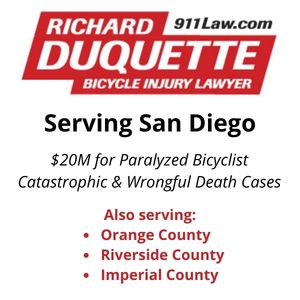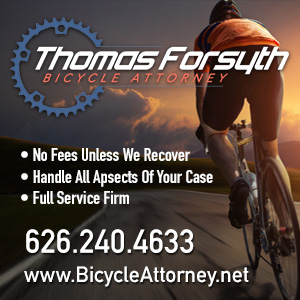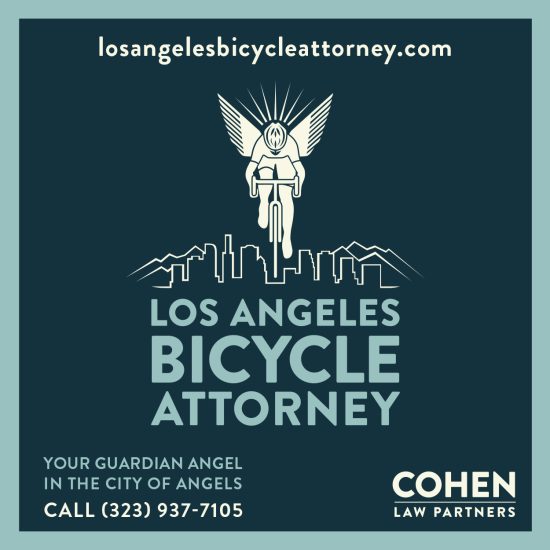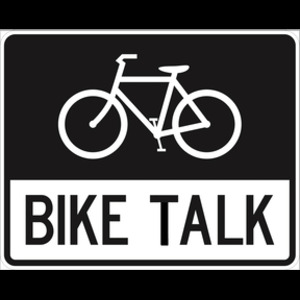Yesterday, Will Campbell was right hooked by a driver in a small car.
A day earlier, a Long Beach cyclist was killed when a truck driver did virtually the same thing.
In the video he posted, you can clearly see the car cut directly across Will’s path, and his rapid reduction in speed as he brakes hard to avoid a collision. And you can hear his restraint as he urges the driver to be more careful in the future.
Now contrast that with the incident in Long Beach, in which an experienced cyclist collided with a semi-truck making a right turn.
According to published reports, Gustavo Ramirez, a 30-year old resident of the Belmont Shore area, was riding eastbound on the sidewalk along East Shoreline Drive in Long Beach about 10:30 am Tuesday, when he hit the side of the truck as it turned onto Shoreline Village Drive. The driver reportedly had missed his exit off the 710 Freeway and was attempting to turn around when the collision occurred.
The popular cyclist, who worked at the Manhattan Beach REI, had survived another recent accident when a car cut him off while riding in the Bixby Knolls area.
Charles Gandy, the mobility coordinator for the city, was quoted as saying that many cyclists feel uncomfortable riding a busy street with no bike lanes like Shoreline Drive, so they may prefer to ride on the sidewalk.
Judging by the city’s website, that may or may not be legal. Long Beach’s municipal code suggests that riding on the sidewalk is allowed in most areas, with a maximum speed limit of 15 mph — 5 mph when pedestrians are present. However, there are a number of exceptions where it’s prohibited; I don’t know the area well enough to say if any of those would apply around there.
Then again, as complicated as the exceptions are, I’m not sure if anyone else does, either.
As a general rule, I advise against riding on the sidewalk, because drivers anticipate cyclists on the sidewalk even less than they do on the street, and aren’t likely to look for you when they’re pulling out of a driveway or turning onto a cross street. In fact, according to a 1998 study by Dr. William Moritz, there’s a 24.8 times greater risk for cyclists riding on the sidewalk as compared to a typical street with no cycling facilities.
However, I can also understand why a cyclist would make an exception there. The southern end of the 710 Freeway dumps heavy traffic directly onto the street just blocks from where Ramirez was killed; more than a few drivers fail to make the mental adjustment from freeway to surface street driving.
It’s clear from the description of the incident that Ramirez collided with the truck, rather than the other way around, striking it on the right side just behind the cab.
Some of the comments online suggest that proves he was at fault. But as Will’s video clearly shows, when a driver turns in front of you without warning, there’s not much you can do except jam on your brakes and pray. If there’s time.
The fact that Ramirez hit the truck just behind the cab suggests that the driver was just beginning his turn when the collision occurred, so there probably wasn’t enough time to react. It also implies that he was probably already alongside the truck when it turned, so he might not have been in a position to see its turn signal, assuming the driver used it.
And even if he was wearing earphones, as a friend of his suggested, it’s highly unlikely that any experienced cyclist would be unaware of such a large truck on the roadway right next to him.
It’s more likely that the driver failed to see Ramirez before turning in front of him; a classic right hook. And a heartbreaking tragedy for his family and friends.
Still, that didn’t stop the usual online comments blaming cyclists from running red lights, calling for licensing and testing — or expecting cyclists to yield regardless of who has the right of way. Or even demanding that the new health care plans impose a surcharge on people who engage in risky behavior like riding a bike.
And that’s not counting the many comments that were deleted for being too offensive. Like the ones questioning whether Ramirez — or the driver — were in the country legally, just because of their names.
It’s tragic enough when any human being loses his life. But no one should have to die simply for riding a bike.
And it shouldn’t be an opportunity for people who hide behind the anonymity of the internet to show just how little compassion and common sense they have.
Members of Midnight Ridazz are planning a ghost bike and memorial ride for Friday the 15th.
………
A Downtown cyclist was run down by a hit-and-run driver yesterday, yet somehow managed to avoid serious injuries. Damien offers the definitive response to the bike plan; the deadline for comments is tomorrow. An L.A. rider tries, and fails, to reach Downtown by following the county bike map. Flying Pigeon gets Belgian-made Achielle bikes in stock. An East Coast cyclist learns to take the whole lane — and in a skirt, no less. Ft. Collins, CO cyclists demand equality, and get the same traffic-calming surcharge drivers face. A New York school bus driver backs over a cyclist in a fatal collision. A Louisville writer goes car-free, and gets a new Pashley. A North Carolina newspaper complains about a planned bike route for “design cyclists,” whatever that is. The League of American cyclists wants to make U.S. university campuses bike friendly. London cyclists outrace the Tube. The hit-and-run plague even extends to Oxford Dons. Adelaide cyclists get a boost in infrastructure spending. A Canadian cyclist is killed by a truck’s oversize load, yet the court rules no one is at fault. Tips on riding in the snow, not that it’s an issue here. Finally, proof that not all cyclists are nice people, even in Copenhagen; then again, neither is everyone who offers to help recover your bike.






